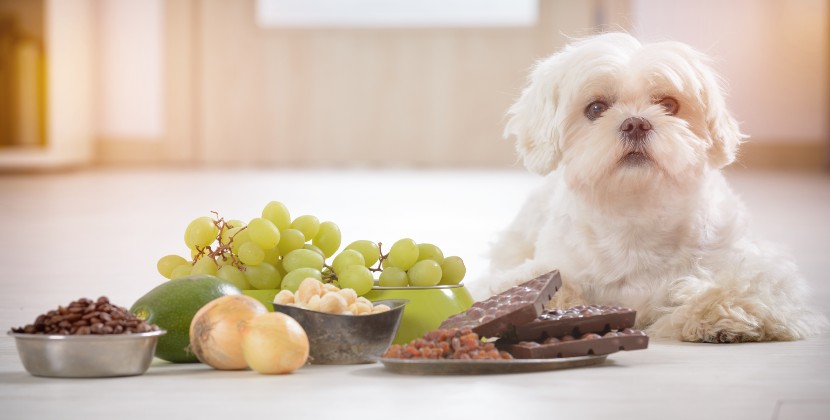
Many dogs like to eat anything and everything they find. Depending on your dog, a walk can involve constant monitoring of what’s been dropped on the sidewalk — much of which can be toxic to dogs.
These hazards aren’t limited to the outdoors, though. Our homes are full of foods that can be toxic for dogs. If your dog is big enough to reach up to the kitchen counter, you’ll know the risks of turning your back for a second.
Whether it’s chocolate or grapes, onions or garlic, as a caring pet parent, knowing what to do if our dog’s eaten something toxic is a big worry.
It’s also important to remember that every dog is unique, and what might be a safe quantity of a food for one dog may be dangerous for another, even if the dogs are the same size or weight, so our advice is it’s best to take no chances when it comes to toxic foods.
So what do you do if your dog has eaten something toxic? And what foods are the most toxic for dogs?
For advice, we spoke to Dr. Mat Glassman, an expert on toxicology in pets and founder and CEO of Dr Cuddles, which produces the ReadyRESCUE first response aid for dogs.
What foods are toxic for dogs?
The list of ‘human foods’ that are toxic to dogs is long. Human foods made up around 20% of dog intoxication incidents in 2017. Here are some major offenders.
Chocolate
Let’s start with the main one we all worry about: chocolate.
Most pet parents are aware that chocolate can be toxic for dogs if eaten in large quantities. But did you know the type of chocolate can make a difference to the toxicity? This is because the more cacao it contains, the more toxic it is.
Dark chocolate is the most dangerous for dogs as it contains more cacao, which has up to 10 times the concentration of theobromine and caffeine compared to milk chocolate. Put simply, the darker and more bitter the chocolate, the more dangerous it is to your dog.
Dark and milk chocolate also contain theobromine and caffeine, which can affect dogs’ GI tract causing vomiting and diarrhea, the heart, urinary incontinence, central nervous system abnormalities, and respiratory and circulatory collapse if consumed in large amounts.
“Theobromine and caffeine are methylxanthines in this classification of a drug that can cause problems,” says Dr. Glassman. “Dogs generally need a fairly high dose of caffeine to have a serious toxic event, and theobromine can cause heart arrhythmias.
“A dog would have to eat about 20 times their bodyweight of white chocolate to have a toxic dose of theobromine, which is not possible. They don’t need to eat much dark chocolate — even for a big dog, just a couple of ounces could cause a problem.
“There are calculators online that you can use to determine whether it might be a toxic dose depending on your dog’s weight, but they can be tricky for some to figure out.”
Grapes and raisins
Both the fruit and the dried version can cause issues for dogs, says Dr. Glassman, but the reason why has yet to be determined.
“Recently, it was hypothesized that the reason why grapes and raisins can be toxic for dogs is due to the presence of tartaric acid. As yet, nobody has done a study to determine this, but there’s a lot of anecdotal evidence that points to this compound.”
Grapes and raisins can be confusing for dog parents, as their toxicity is idiosyncratic and not necessarily dose-dependent.
“You can have one dog whose owner has been giving it a couple of grapes a day for its entire life and there’s no problem, while another dog could eat a few raisins and go into kidney failure. That’s difficult for vets — there’s not a lot they can do apart from put them on fluids and support their kidney function.”
Onions and garlic
According to Dr. Glassman, onions and garlic can damage a dog’s red blood cells, but usually only in large amounts.
“It’s fairly dose-dependent and dogs need to eat a good amount — like a soup with a bunch of onions in or a whole head of garlic,” he says.
Products containing THC
While well-made CBD products for dogs are perfectly safe, some products used by humans are not canine-friendly. This is because they can contain the psychoactive ingredient THC. Obviously, dogs don’t know the difference.
“The biggest issue is that dogs are very sensitive to THC, which some human CBD products contain, and they don’t get rid of it as quickly as humans, so it builds up in their system,” says Dr. Glassman. “Dogs are also unable to rationalize why they’re feeling stoned, which is an unpleasant situation for them.”
What are the symptoms and signs of poisoning in dogs?
Often, if your dog is suffering a reaction to something toxic, you’ll know fairly quickly by the fact they start vomiting within 24 hours post-ingestion, or have diarrhea. They may also appear fatigued, lose their appetite and be out of sorts. If they’re suffering kidney damage, they may be excessively thirsty and suffer an increased need to urinate.
Usually, there will be other evidence they’ve eaten something toxic, as you will catch them in the act or realize half your bunch of grapes has mysteriously vanished off the counter…
What to do if you realize your dog has eaten something toxic
Note what they’ve eaten
“Determine the maximum amount of toxin your pet ate and note the exact type. E.g. is the chocolate white, dark or other. This information will be crucial in determining how worried one should be and next steps,” says Dr. Glassman.
Know your dog
“If you have an animal that has a history of pancreatitis or a history of an easily upset stomach, you may want to be more proactive with intervention and administer a non-specific gastrointestinal decontaminant or binder like ReadyRESCUE.”
Monitor
“Watch for signs of stomach upset or distress. You may also want to feed your pet some canned pumpkin or rice to help bulk their stool up in case diarrhea is imminent.”
Call a vet
“The longer you take, the more quickly the toxic food will be absorbed,” says Dr. Glassman. “My advice is to get to your vet as quickly as possible and they can induce vomiting.”
He has also developed a first-response aid called Dr. Cuddles’ ReadyRescue. This is similar to the tools used by many vets when an animal has eaten something toxic.
“If you think your pet has eaten something toxic, give them a dose of ReadyRescue immediately so that you’ve got something on board that’s working right away. If it turns out they didn’t need something, it’s harmless and will pass through. Meanwhile, make a note of how much they ate and contact your veterinarian or poison control to see if that’s a toxic dose.”
Dr Cuddles’ ReadyRescue is a nonspecific binder onto anything — think of it as a giant sponge, says Dr. Glassman. “When an animal eats a toxin, it’s not properly in their body until it’s absorbed from the GI tract. ReadyRescue is made from tiny beads of activated charcoal that absorb anything that’s in high concentration, holding on to it and carrying it out of the GI tract so the dog doesn’t suffer so many effects or damage to the kidneys.”
What will your vet do?
Your vet will weigh your dog, and ask how much of the food you think, or know, your dog ate. They will then induce vomiting and check that the food has been brought up.
In more serious cases, the vet may do blood tests, a serum biochemistry profile or urinalysis, and your dog may be put on fluids for 48 hours to help support the kidneys and kept in for observation.
You may also be given a charcoal treatment to administer to your dog at home in case any of the toxin remains.
How to keep your dog safe from toxins around the house and garden
The main way to lower the risk of your dog eating toxic food is to keep harmful foods and substances well away from them. If you have any high-risk foods such as grapes, raisins, items with raisins in or chocolate, ensure they’re stored securely in high cupboards or the fridge.
Dr Cuddles’ ReadyRescue is a useful product to have to hand in case of emergency, but the important thing to remember is that if your pet does eat anything toxic, act quickly and try not to panic — the ASPCA Poison Control estimates that 25% of poisoned pets recover within two hours.
Contact your veterinary surgeon who can provide advice on the best course of action to ensure your dog doesn’t suffer any serious long-term effects from the toxins within the food.



